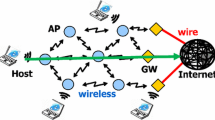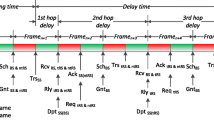Abstract
This paper proposes a profile-based network and hardware co-simulation method to investigate the overall performance and real-timing characteristics of a wireless mesh network (WMN) affected by hardware capabilities, speed and complexity. For the sophisticated algorithms to be assisted by a hardware realization, we adopt the RObust Header Compression (ROHC) and packet aggregation that provide high and reliable data transmission over unstable wireless links, which is proven in the preliminary works. To verify the hardware support needs to get the benefit of the two algorithms, we measure the ROHC processing time from Intel Pentium 4 and RouterBOARD, and identify the deterioration of sensor throughput and successful voice calls under various NS-2 simulation scenarios. The co-simulation method integrates the network level simulator, NS-2 and hardware level simulator, SystemC. In this approach, we first insert the modules of ROHC and packet aggregation algorithms into the network simulator hierarchy, and measure the packet arrival times. Then, the corresponding hardware architecture is designed by SystemC for profiling the hardware delay appeared in encoding and decoding packets. The hardware is suitably designed to reduce the complexity and make a sufficient speedup in the packet processing. Finally, the traced hardware delays are applied into the network level simulator to extract real-timing WMN behaviors changed by the hardware operations in each mesh router.




















Similar content being viewed by others
References
Akyildiz, I. F. (2005). A survey on wireless mesh networks. IEEE Radio Communications, Sept. 2005.
Burmeister, C., Degermark, M., Fukushima, H., Hannu, H., Jonsson, L.-E., Hakenberg, R., Koren, T., Le, K., Liu, Z., Martensson, A., Miyazaki, A., Svanbro, K., Wiebke, T., Yoshimura, T., & Zheng, H. (2001). Robust header compression (ROHC): Framework and four profiles: RTP, UDP, ESP, and uncompressed, RFC 3095, July 2001.
Network Simulator-2, http://www.isi.edu/nsnam/ns.
SystemC, http://www.systemc.org.
RouterBOARD, http://www.routerboard.com.
Powerimpact, http://ee.ucla.edu/PowerImpact.
Brooks, D., Tiwari, V., & Martonosi, M. (2006). Wattch, A Framework for Architectural-level Power Analysis and Optimizations. International Sypmosium on Computer Architecture, June 2006.
Sinha, A., & Chandrakasan, A. P. (2001). JouleTrack: A Web based Tool for Software Energy Profiling. Design Automation Conference, 2001.
GloMoSim, http://pcl.cs.ucla.edu/projects/glomosim.
MaRS, http://www.cs.umd.edu/projects/netcalliper/software.html.
Chatelain, A., Mathys, Y., Placido, G., La Rosa, A., & Lavagno, L. (2001). High-Level Architectural Co-Simulation Using Esterel and C. CODES, 2001.
Nicolescu, G., Yoo, S., & Jerraya, A. A. (2001). Mixed-Level Cosimulation for Fine Gradual Refinement of Communication in SoC Design. DATE, 2001.
Park, H., Liao, W., Tam, K. H., Srivastava, M. B., & He, L. (2003). A Unified Network and Node Level Simulation Framework for Wireless Sensor Networks. Department of Electrical Engineering, UCLA, 2003.
Aue, V., Kneip, J., Weiss, M., Bolle, M., & Fettweis, G. (2001). Matlab Based Co-Design Framework for Wireless Broadband Communication DSP. ASSP, 2001.
Hardware/Software/Network Co-Design Tool (HSN), http://eda.sci.univr.it/.
Gallo, P., Poncino, M., Martini, S., Ricciato, F., Fummi, F., & Perbellini, G. A. (2003). Timing-accurate Modeling and Simulation Environment for Networked Embedded Systems. DAC 2003.
Rein, S., & F. H. P. Fitzek (2003). Voice quality evaluation for wireless transmission with ROHC. IASTED Conference on Internet and Multimedia Systems and Applications, 2003.
Sridharan, R. A robust header compression technique for wireless ad hoc networks. MobiHoc03, June, 2003, Annapolis, Maryland, USA.
Minaburo, A. C., Singh, K. D., Toutain, L., & Nuaymi, L. (2004). Proposed behavior for robust header compression over a radio link. IEEE International Conference on Communications. June, 2004.
Taylor, D. E., Herkersdorf, A., Doring, A., & Dittmann, G. (2005). Robust header compression (ROHC) in next-generation network processors. IEEE/ACM Transactions on Networking, 13(4), 755–768.
Jung, S., Hong, S., & Park, P. (2006). Effect of RObust Header Compression (ROHC) and packet aggregation on multi-hop wireless mesh networks. IEEE International Conference on Computer and Information Technology (CIT). Seoul, Korea, Sept. 20–22, 2006.
Kim, K., & Hong, S. (2006). VoMESH: Voice over wireless MESH networks VoMESH: Voice over wireless MESH networks. WCNC. May, 2006.
Ashish Jain, M. N. D. G., & Gruteser, M. (2003). Benefits of packet aggregation in ad-hoc wireless network. Department of Computer Science, University of Colorado at Boulder, Tech. Rep. CU-CS-960-03, 2003.
Hideaki Yamada, N. H. (2001). Voice quality evaluation of ip-based voice stream multiplexing schemes. Local Computer Networks (LCN). 2001.
Komolafe, R., & Gardner, O. (2003). Aggregation of VoIP Streams in a 3G mobile network: A teletraffic perspective. European Personal Mobile Communications Conference (EPMCC). 2003.
Cle, R., & Rosenbluth, J. (2001). Voice over IP performance monitoring. ACM Computer Communication Review, 31, April 2001.
Ganguly, S., Navda, V., Kim, K., Kashyap, A., Niculescu, D., Izmailov, R., Hong, S., & Das, S. R., (2006). Performance optimizations for deploying VoIP services in mesh networks. IEEE Journal on Selected Areas in Communications, 24(11), 2147–2158.
ROHC-Robust Header Compression, http://rohc.sourceforge.net.
Mica Motes, http://www.xbow.com.
Telos Motes, http://www.moteiv.com
Kohler, E., Morris, R., Chen, B., Jannotti, J., & Kaashoek, M. F. (2000). The click modular router. ACM Transactions on Computer Systems, 18, 263–297.
Author information
Authors and Affiliations
Corresponding author
Rights and permissions
About this article
Cite this article
Jung, S., Hong, S. Network/hardware cross-layer evaluation for ROHC and packet aggregation on wireless mesh networks. Wireless Netw 15, 1086–1101 (2009). https://doi.org/10.1007/s11276-008-0104-7
Published:
Issue Date:
DOI: https://doi.org/10.1007/s11276-008-0104-7




